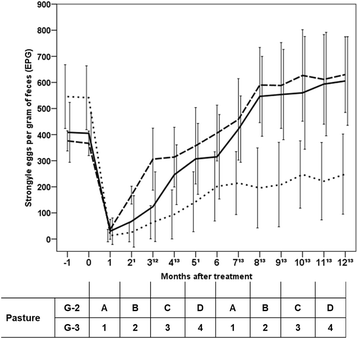A combined effort to avoid strongyle infection in horses in an oceanic climate region: rotational grazing and parasiticidal fungi
- PMID: 29650055
- PMCID: PMC5897951
- DOI: 10.1186/s13071-018-2827-3
A combined effort to avoid strongyle infection in horses in an oceanic climate region: rotational grazing and parasiticidal fungi
Abstract
Background: An approach to preventing strongyle infection in horses was tested, comprising rotational pasturing and the administration of spores of two parasiticidal fungi, Mucor circinelloides and Duddingtonia flagrans.
Methods: Twenty-two adult Spanish Sport Horses were dewormed with ivermectin (1 mg pour-on/kg body weight) and then randomly divided into three groups. G-1 was maintained with continuous grazing, and G-2 and G-3 were kept on a four-paddock rotation system. Commercial pelleted feed (2.5 kg/horse) was supplied to G-1 and G-2 twice a week; horses in G-3 received pellets containing 2 × 106 spores/kg of each fungus. Fecal samples were analyzed by the flotation method to estimate the reduction in the fecal egg counts (FECR), the percentage of horses shedding eggs (PHR), and the egg reappearance period (ERP).
Results: Third-stage larvae were identified in fecal pats as Cyathostomum (sensu lato) types A, C and D, Gyalocephalus capitatus, Triodontophorus serratus, Poteriosthomum spp., Strongylus vulgaris and S. edentatus. Two weeks after treatment, the FECR values were 100% in G-1, 96% in G-2 and 99% in G-3; the PHR values were 100% in G-1, 75% in G-2 and 88% in G-3. A strongyle ERP of 6 weeks was observed in G-1, ERP of 10 weeks was observed in G-2, and ERP of 16 weeks was observed in G-3. The counts of eggs per gram of feces (EPG) were > 300 EPG in G-1 and G-2 but remained below 250 EPG in G-3 throughout the observation period of 12 months.
Conclusions: These results suggest that horse strongyle infection could be decreased by combining rotational pasturing with feeding pellets containing the spores of parasiticidal fungi.
Keywords: Duddingtonia flagrans; Horses; Integrated control; Mucor circinelloides; Pelleted feed; Rotational pasturing; Strongyles.
Conflict of interest statement
Ethics approval
Not applicable.
Consent for publication
Not applicable.
Competing interests
The authors declare that they have no competing interests.
Publisher’s Note
Springer Nature remains neutral with regard to jurisdictional claims in published maps and institutional affiliations.
Figures



References
-
- Sanchís Polto J, Madeira de Carvalho LM, Bonilla R, Duque de Araújo AM, Arroyo F, Suárez J, et al. Horse handling conditions and emergence of neglected infections: fasciolosis. In: Paz-Silva A, Arias MS, Sánchez-Andrade R, et al., editors. Horses: breeding, health disorders and effects on performance and behaviour. New York: Nova Publishers; 2014. pp. 127–144.
-
- Sokół R, Raś-Noryńska M, Michalczyk M, Raś A, Rapacz-Leonard A, Koziatek S. Estimation of infection of internal parasites in horses from different type of farms. Ann Parasitol. 2015;61:189–192. - PubMed
Publication types
MeSH terms
Grants and funding
- AGL2012-34355 and CTM2015-65954-R/Ministry of Economy and Competitiveness, Spain; FEDER/International
- Ramón & Cajal Program/Ministry of Economy and Competitiveness, Spain/International
- postdoctoral research fellowship/Consellería de Cultura, Educación e Ordenación Universitaria, Xunta de Galicia/International
LinkOut - more resources
Full Text Sources
Other Literature Sources
Miscellaneous

